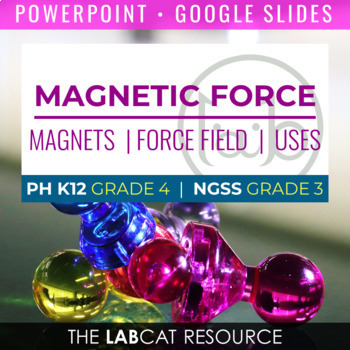MAGNETIC FORCE: Properties, the Magnetic Field, and Uses of Magnets
- Zip
- Google Apps™

Also included in
- Looking for a full lecture presentation on the unit of Force and Motion? Then look no further!Enhance the students' learning experience with this bundle of fully editable animated presentations. They all come with interactive Google Slides versions for absentees and homeschoolers. Packed with high qPrice $7.50Original Price $9.00Save $1.50
Description
Put the VISUAL in your visual aid with this stunning presentation!
Enhance the students' learning experience during lecture with this fully editable animated presentation. It comes with an interactive Google Slides version for absentees and homeschoolers. Packed with high quality images and easy to understand graphic organizers, this presentation would surely make science concepts easier to understand and recall.
Features:
- Visually-stimulating
- Engaging questions
- Graphic organizers
- 60+ enriching slides
- 100% editable
- Good for flexible learning
Alignment:
IF you are in the Philippines, then this is fully aligned with the PH K12 Curriculum:
- S4FE-IIId-e-3: Describe the force exerted by magnets.
If you are in the USA, then this is fully aligned with the NGSS:
- 3-PS2-3: Ask questions to determine cause and effect relationships of electric or magnetic interactions between two objects not in contact with each other;
- 3-PS2-4: Define a simple design problem that can be solved by applying scientific ideas about magnets.
Topics Included:
- Properties of Magnets
- Law of Magnetism
- Magnets and Compass
- The Magnetic Field
- Uses of Magnets
Included in the Product:
1. PowerPoint Presentation
- Best for teacher-led instruction.
- Meant to be presented in front of the class.
- Sectioned by subtopic for easier navigation.
- Bigger font size and images.
- Contains animations and transitions.
2. Google Slides
- Best for self-paced instruction.
- Can be given as a reviewer for homeschoolers and absentees.
- Elements are hidden in Theme Builder to avoid accidental modification.
- Questions can be answered by means of typing.
100% Fully Editable Feature
PowerPoint Presentation
- Add, delete and modify the slides to fit you students' needs.
Google Slides
- Noneditable by the students (except for the answer textboxes).
- Editing features can be accessed by the teacher via Theme Builder.
Note: Some objects and media are flattened, but replaceable.
CLICK HERE FOR A SAMPLE ON HOW THIS PRODUCT WORKS.
May you spark the love for learning!






